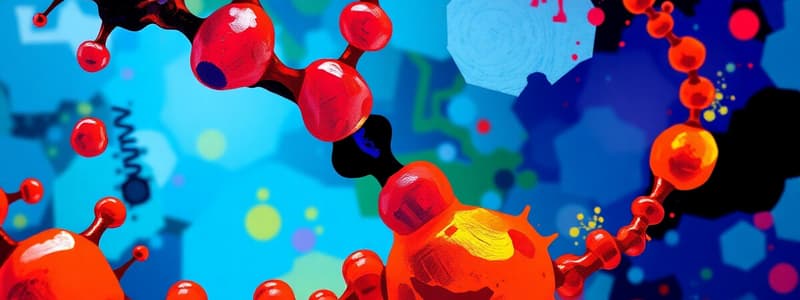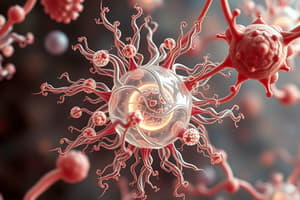Podcast
Questions and Answers
Which of the following statements accurately describes the relationship between biomolecules and macromolecules?
Which of the following statements accurately describes the relationship between biomolecules and macromolecules?
- Macromolecules are a type of biomolecule, but not all biomolecules are macromolecules (correct)
- Macromolecules are a subset of biomolecules.
- Biomolecules and macromolecules are unrelated terms.
- All biomolecules are macromolecules.
What is the primary difference between uric acid and ATP, as discussed in the text?
What is the primary difference between uric acid and ATP, as discussed in the text?
- Uric acid is a waste product, while ATP is a crucial energy molecule. (correct)
- Uric acid is a protein, while ATP is a carbohydrate.
- Uric acid is a macromolecule, while ATP is a small biomolecule.
- Uric acid is found only in animals, while ATP is found in all living organisms.
Which of these molecules would be classified as a macromolecule based on the definition provided in the text?
Which of these molecules would be classified as a macromolecule based on the definition provided in the text?
- Uric acid (molecular weight 168 g/mol)
- A protein with a molecular weight of 1,000 g/mol
- A protein with a molecular weight of 10,000 g/mol (correct)
- ATP (molecular weight 507 g/mol)
What is the significance of monomers in the context of macromolecules?
What is the significance of monomers in the context of macromolecules?
The text highlights the complexity of macromolecules. Why is this complexity significant?
The text highlights the complexity of macromolecules. Why is this complexity significant?
Which of the following is NOT an example of a monomer?
Which of the following is NOT an example of a monomer?
Based on the information provided, which of the following would be considered a macromolecule?
Based on the information provided, which of the following would be considered a macromolecule?
Why do scientists use the term "biomolecule" to describe molecules in living organisms?
Why do scientists use the term "biomolecule" to describe molecules in living organisms?
Which subcellular organelle is responsible for processing and packaging proteins destined for secretion or other cellular locations?
Which subcellular organelle is responsible for processing and packaging proteins destined for secretion or other cellular locations?
Which of the following is NOT a function of the rough endoplasmic reticulum?
Which of the following is NOT a function of the rough endoplasmic reticulum?
What are the three main categories that cells can be classified into based on phylogeny?
What are the three main categories that cells can be classified into based on phylogeny?
What is the main function of peroxisomes?
What is the main function of peroxisomes?
Which of the following is a characteristic feature of lysosomes?
Which of the following is a characteristic feature of lysosomes?
What is the name given to the entire volume of a prokaryotic cell, including the cytosol and suspended particles?
What is the name given to the entire volume of a prokaryotic cell, including the cytosol and suspended particles?
Which organelle is responsible for the production of ATP, the cell's energy currency?
Which organelle is responsible for the production of ATP, the cell's energy currency?
What is the primary difference between prokaryotic cells and eukaryotic cells?
What is the primary difference between prokaryotic cells and eukaryotic cells?
What is the name of the localized area in prokaryotes that contains bacterial chromosomes and associated proteins?
What is the name of the localized area in prokaryotes that contains bacterial chromosomes and associated proteins?
In plant cells, which organelle performs a similar function to lysosomes in animal cells?
In plant cells, which organelle performs a similar function to lysosomes in animal cells?
What is the function of ribosomes in prokaryotic cells?
What is the function of ribosomes in prokaryotic cells?
What is the main role of the cell wall in plant cells?
What is the main role of the cell wall in plant cells?
What is the name given to the collection of metabolites found within a prokaryotic cell?
What is the name given to the collection of metabolites found within a prokaryotic cell?
Which of the following statements accurately describes the cytoskeleton?
Which of the following statements accurately describes the cytoskeleton?
Which of the following is NOT a feature shared by all cells?
Which of the following is NOT a feature shared by all cells?
What is the primary function of the nuclear envelope?
What is the primary function of the nuclear envelope?
What is the composition of the plasma membrane?
What is the composition of the plasma membrane?
Which of the following is a defining characteristic of eukaryotes?
Which of the following is a defining characteristic of eukaryotes?
Which organelle is responsible for the synthesis of phospholipids that form the plasma membrane?
Which organelle is responsible for the synthesis of phospholipids that form the plasma membrane?
How does the plasma membrane adapt when a cell grows or divides?
How does the plasma membrane adapt when a cell grows or divides?
What is the significance of the plasma membrane being flexible?
What is the significance of the plasma membrane being flexible?
Which cellular process involves the conversion of glucose into ATP?
Which cellular process involves the conversion of glucose into ATP?
What is the function of the proteins embedded in the plasma membrane?
What is the function of the proteins embedded in the plasma membrane?
Which of the following best describes the relationship between the rough ER and the smooth ER?
Which of the following best describes the relationship between the rough ER and the smooth ER?
Which of these is NOT a characteristic of mitochondria?
Which of these is NOT a characteristic of mitochondria?
What is the main function of the genome in a prokaryotic cell?
What is the main function of the genome in a prokaryotic cell?
Which of the following is NOT a characteristic of prokaryotic cells?
Which of the following is NOT a characteristic of prokaryotic cells?
What is the primary function of the chloroplast in plant cells?
What is the primary function of the chloroplast in plant cells?
Which of the following is NOT a function of the vacuole in plant cells?
Which of the following is NOT a function of the vacuole in plant cells?
What types of environments do Archaea typically inhabit?
What types of environments do Archaea typically inhabit?
Which of the following statements about supramolecular complexes is TRUE?
Which of the following statements about supramolecular complexes is TRUE?
Which of the following is an example of a supramolecular complex?
Which of the following is an example of a supramolecular complex?
Flashcards
Biomolecules
Biomolecules
Molecules part of or secreted by cells, essential for life.
Gout
Gout
A painful condition caused by excess uric acid in the bloodstream.
Adenosine triphosphate (ATP)
Adenosine triphosphate (ATP)
The primary energy molecule for cells, containing multiple functional groups.
Macromolecules
Macromolecules
Signup and view all the flashcards
Titin
Titin
Signup and view all the flashcards
Monomers
Monomers
Signup and view all the flashcards
Functional groups
Functional groups
Signup and view all the flashcards
Small biomolecules
Small biomolecules
Signup and view all the flashcards
Metabolites
Metabolites
Signup and view all the flashcards
Eukaryotes
Eukaryotes
Signup and view all the flashcards
Plasma Membrane
Plasma Membrane
Signup and view all the flashcards
Organelles
Organelles
Signup and view all the flashcards
Nuclear Envelope
Nuclear Envelope
Signup and view all the flashcards
Ribosomes
Ribosomes
Signup and view all the flashcards
Rough Endoplasmic Reticulum (Rough ER)
Rough Endoplasmic Reticulum (Rough ER)
Signup and view all the flashcards
Smooth Endoplasmic Reticulum (Smooth ER)
Smooth Endoplasmic Reticulum (Smooth ER)
Signup and view all the flashcards
Golgi Apparatus
Golgi Apparatus
Signup and view all the flashcards
Peroxisome
Peroxisome
Signup and view all the flashcards
Lysosome
Lysosome
Signup and view all the flashcards
Vacuole
Vacuole
Signup and view all the flashcards
Mitochondria
Mitochondria
Signup and view all the flashcards
Cell Wall
Cell Wall
Signup and view all the flashcards
Cytoskeleton
Cytoskeleton
Signup and view all the flashcards
Supramolecular complexes
Supramolecular complexes
Signup and view all the flashcards
Prokaryotes
Prokaryotes
Signup and view all the flashcards
Cytoplasm
Cytoplasm
Signup and view all the flashcards
Nucleoid
Nucleoid
Signup and view all the flashcards
Genome
Genome
Signup and view all the flashcards
Metabolome
Metabolome
Signup and view all the flashcards
Cellular membrane
Cellular membrane
Signup and view all the flashcards
Membrane-bound organelles
Membrane-bound organelles
Signup and view all the flashcards
Lipids
Lipids
Signup and view all the flashcards
Carbohydrates
Carbohydrates
Signup and view all the flashcards
Proteins
Proteins
Signup and view all the flashcards
Study Notes
Biomolecules
- Biomolecules are molecules part of or excreted by cells.
- Examples include uric acid, excreted into the bloodstream, and ATP, crucial for energy production.
- Uric acid (168 g/mol) and ATP (507 g/mol) are relatively small.
- Larger biomolecules (5000 g/mol and above) are called macromolecules.
- Examples of macromolecules include proteins (like insulin), carbohydrates (like starch), and DNA.
- Macromolecules are built from monomers: amino acids for proteins, nucleotides for DNA/RNA, and sugars for carbohydrates.
- Macromolecules are linked to form supramolecular complexes: proteins working together to perform a cellular function, or a protein interacting with DNA for repair.
Cellular Basics
- All cells are defined by a plasma membrane separating the inside from the outside environment.
- Multicellular organisms have various specialized cell types. Single-celled organisms have smaller cells.
- The plasma membrane consists of lipids and proteins—making it water and ion impermeable—and flexible.
- Protein channels allow transport of water, ions, and nutrients.
Prokaryotic Cells
- Prokaryotes (bacteria and archaea) are smaller than eukaryotes (typically 1-10 μm or 0.3 μm for some bacteria).
- Basic structure: plasma membrane enclosing cytoplasm (cytosol + suspended particles).
- Nucleoid: localized region of bacterial chromosomes (about 20% of the cell volume).
- Ribosomes (about 8% of the cell volume): protein-RNA complexes for protein synthesis.
- Metabolome: collection of metabolites, small organic molecules essential for cell survival (analogous to the genome).
- Typical prokaryotic cells contain about 27,000 ribosomes.
Eukaryotic Cells
- Eukaryotes are larger than prokaryotes (typically 5-100 μm).
- More complex structure than prokaryotes: contain membrane-bound organelles.
- Organelles define separate spaces for specialized functions.
- Nucleus: contains the cell's genome/chromosomes within a nuclear envelope.
- Ribosomes: scattered throughout cytoplasm OR attached to the rough endoplasmic reticulum (RER) for protein synthesis.
- RER: synthesizes and processes proteins destined for the plasma membrane.
- Smooth endoplasmic reticulum (SER): synthesizes lipids, phospholipids and stores Ca+2.
- Golgi apparatus: processes and transports products from RER.
- Peroxisomes: detoxify molecules like hydrogen peroxide (liver cells also detoxify ethanol).
- Lysosomes: digest macromolecules in animal cells (acidic pH for degradation).
- Vacuoles: storage centers in plant, fungal, and other cells (store water, ions, pigments).
- Mitochondria: generate ATP through cellular respiration using glucose. -The number of mitochondria is approximately between 400 and 900 per cell.
- Chloroplasts: convert sunlight to chemical energy in plants (analogous to mitochondria).
- Structural components (not organelles), including cell walls for fungi, algae, and plants to provide support outside plasma membrane, and cytoskeleton within the cell maintaining shape and structure.
Cellular Energy Production
- Cellular respiration converts glucose to ATP: C6H12O6 + 6O2 → 6CO2 + 6H2O + Energy (ATP)
- Respiration takes place in multiple steps, with the first in cytosol and final steps in mitochondrion.
Studying That Suits You
Use AI to generate personalized quizzes and flashcards to suit your learning preferences.



